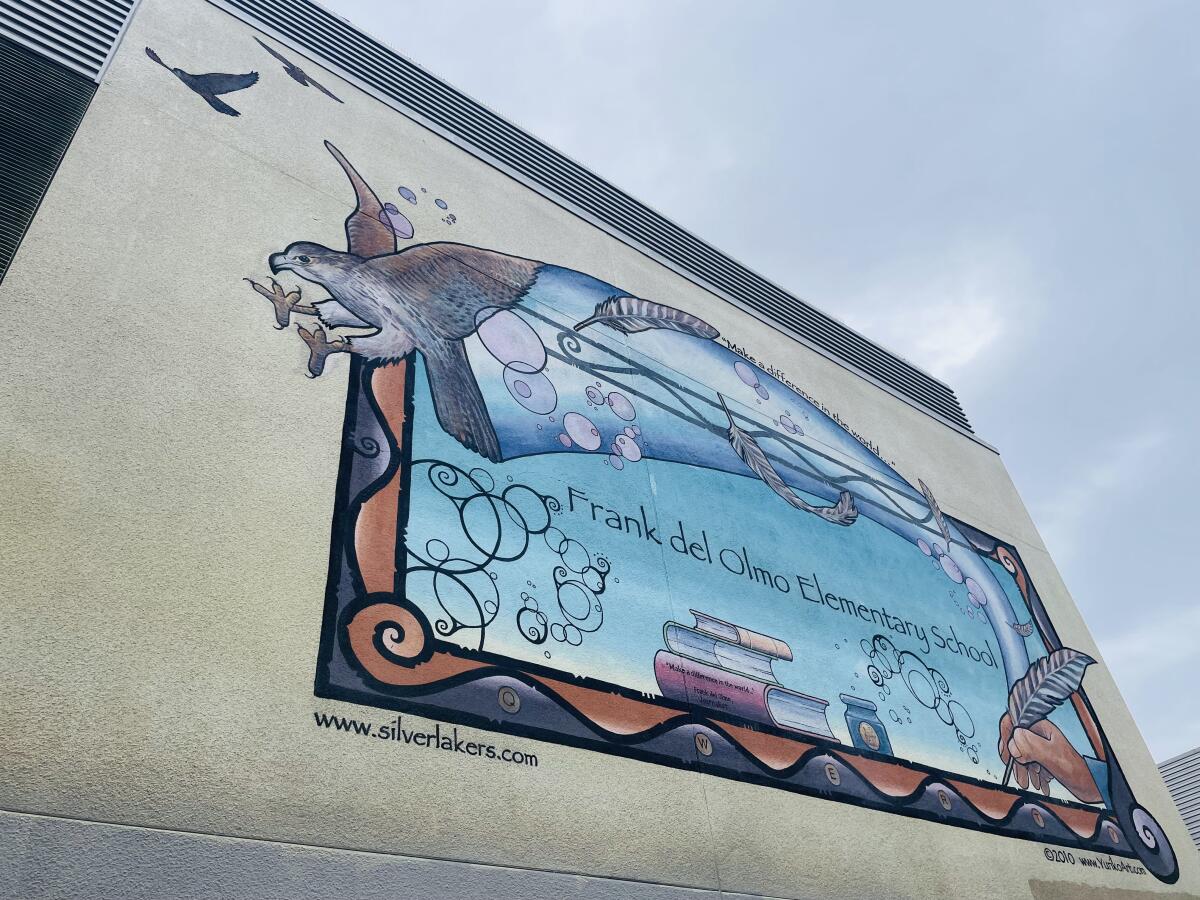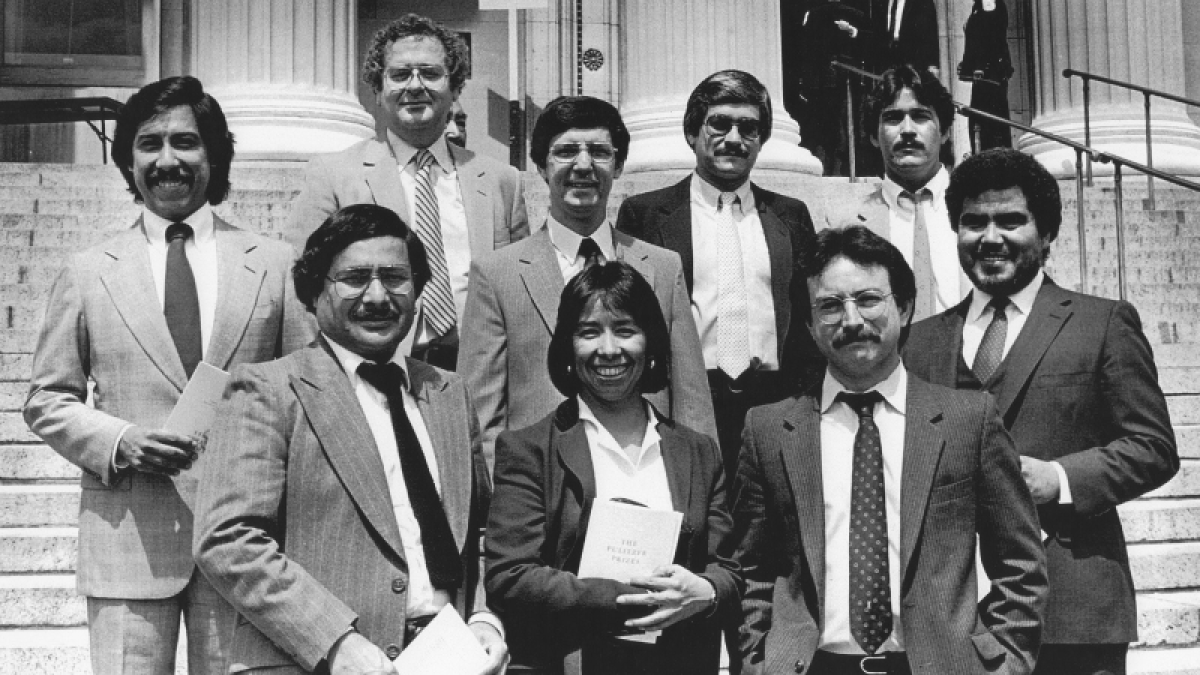L.A. forgot Times journalist Frank del Olmo. So did the school named after him

- Share via
Staff members at Frank del Olmo Elementary were puzzled when I asked about the school’s namesake.
His name was all around us, after all. On the fanciful mural of books, a falcon (the school mascot), a quill pen and ink well with the slogan “Make a Difference in the World.” On school T-shirts advertised for sale on banners in English and Spanish hanging from a fence. On the framed, fancy city proclamation signed in 2006 by then-Mayor Antonio Villaraigosa to mark the opening of this boxy, two-story, three-acre school on the edge of Historic Filipinotown.
But I couldn’t find much that told the world who Frank del Olmo was. A trailblazing reporter, columnist and editor for the Los Angeles Times. The first Latino on the paper’s masthead. A founding member of the California Chicano News Media Assn. An inductee into the National Assn. of Hispanic Journalists Hall of Fame. A longtime champion of the oppressed, and a burr to the powerful.
I visited Frank del Olmo Elementary on Tuesday to pay my respects, a day after the 20th anniversary of his death from a heart attack at just 55 outside his office at the old downtown Times headquarters, which drew condolences from then Mexican President Vicente Fox and Nobel Prize laureate Gabriel García Márquez. At Del Olmo’s funeral, then-Times editor John Carroll told an audience of nearly 900 that the paper and Los Angeles would “always remember” Del Olmo.
We didn’t.
Veteran columnist, a Pulitzer winner, rose through the ranks and mentored many.
The only hint of Del Olmo’s accomplishments I could find was on that mural facing Vermont Avenue. Under his name was the word “journalist.” The inkwell bore a faint outline of the Pulitzer Prize medal, which he and other staffers won in 1984 for a pioneering series on Latinos in Southern California.
I thought I’d find more at the school’s entrance, where two plaques were bolted on columns. Nope. One plaque commemorated “the Americanization of Godzilla,” which took place in 1956 when footage was filmed here for the English-language version of the monster classic. The other saluted the firm that finished building the school, more than a year behind schedule.
A secretary then remembered that there was something scratched out on the sidewalk just in front of the attendance office. I briskly walked outside. A concrete slab bore the name of Frank del Olmo Elementary’s founding principal and imprints of his hands.

Del Olmo never entered the public consciousness like his predecessor, Ruben Salazar, the Times columnist killed in 1970 by a tear gas canister fired by a Los Angeles County sheriff’s deputy during the Chicano Moratorium in East Los Angeles. Del Olmo’s work barely registers in journalism schools today. This paper long ago ended its Frank del Olmo Impact Award for a high school newspaper whose work made a difference in the community. One of the only traces of him in the journalism world is a scholarship in his name from CCNMA: Latino Journalists of California. A friend had to remind me that Monday marked 20 years since Del Olmo’s death, and then I had to remind colleagues.
Obsolescence is sadly the fate of most reporters. We write our stories, we hope for a reaction from readers that often doesn’t come, we move on to the next article. Our clips inevitably gather literal and digital dust, remembered only by a few. And that’s a career.
It’s a fate that Del Olmo doesn’t deserve. He and the late Wall Street Journal reporter Daniel Pearl are the only journalists with a Los Angeles Unified school named after them. It’s because of Del Olmo that The Times has as many Latino reporters and editors as we do. He fought for representation in the newsroom and in our stories to the literal end of his life. On that day, Del Olmo was supposed to have lunch with Latino staffers to discuss how management could better support an initiative to cover Latinos, recalled former Times editor Frank Sotomayor and current Times editors Steve Padilla and Nancy Rivera Brooks.
We’ve never marked the anniversary of Del Olmo’s death in the five years I’ve been here — not a Slack post, not a companywide email, nada. So I wasn’t surprised that the school has forgotten as well. If there’s little to mark Del Olmo’s legacy at his namesake school and the paper where he worked, how can we expect the rest of the city to remember him?
We all have friends whom we never actually meet, and Times Associate Editor Frank del Olmo was one of mine (obituary, Feb. 20).
Staff buzzed me back into the office. Waiting for me this time was second-year assistant principal Veronica Ciafone.
“I didn’t know who Frank del Olmo was before I transferred here, so I read all about him,” the 45-year-old South L.A. native said as we walked across campus toward the library. Someone had mentioned they thought a Del Olmo marker was there. “I wanted to understand why they would name a school after a person and not after a street.”
Just inside the library entrance was a framed yellow poster featuring a black-and-white image of a smiling Del Olmo. “My hope has been for a career that would allow [me] to make at least a small difference in the world,” it stated in Spanish.
“He died young, didn’t he?” Ciafone said before asking the librarian if there was anything else. Nothing.
The lunch bell rang. I expected a rush of kids. I hoped to ask if they knew anything about Del Olmo. No one came.
“Rainy day schedule,” Ciafone said with a smile.
We walked back to her office, decorated with mementos from her career — photos, a small Chinese dragon, a USC pennant. She reached into her desk and pulled out a hardcover edition of “Frank del Olmo: Commentaries on His Times,” an anthology of his work published a few months after his death.
“In college, we heard a lot about Ruben Salazar, but nothing about Frank del Olmo,” she admitted. “Even where I was before, I remember there was a Ruben Salazar scholarship.”
Ciafone searched on her laptop. She showed me a flier for it.
“It’s unfortunate,” said the daughter of Mexican immigrants, “because Frank del Olmo’s contributions to Latinos were obviously significant as well.”
He was more than just a figurehead Latino, I responded. Del Olmo is pigeonholed as a Chicano voice — but he was an L.A. voice, period.

He wrote about secession fights in his native San Fernando Valley and the rise of labor in city politics. He excoriated this paper for endorsing Pete Wilson’s 1994 reelection after the California governor hitched his campaign to the noxious Proposition 187. Police brutality, civic corruption, even sports: Del Olmo covered it all in a taut, thorough style.
But his most beautiful columns, I told Ciafone, were those about his son, Frankie. Every December for a decade beginning in 1995, he told readers about Frankie’s life with autism, starting from the boy’s diagnosis at age 3. In a dispatch Del Olmo wrote two months before his death, he announced that “the two great gifts” he could give his son “are my presence and his privacy. And he shall have them both.”
Ciafone browsed through some of those Frankie columns. Her eyes widened with each page. Then she reached the end, an excerpt from a homework assignment Frankie did about his father.
“My dream is that I can be a great man like my dad,” the assistant principal slowly read out loud, “so I can do good things like he did.”
She closed the book and dabbed at her eyes.
As we said our goodbyes, I asked if there was any chance that students might be able to learn more about Frank del Olmo. She thought about it. “We’re having Career Day in a few months, so it would be nice to honor him.”
“Are you going to have a reporter?” I blurted out.
Ciafone grinned.
“We can — would you like to come and tell our students about Frank del Olmo?”
It would be my honor.
More to Read
Sign up for Essential California
The most important California stories and recommendations in your inbox every morning.
You may occasionally receive promotional content from the Los Angeles Times.














